Hakobi Tenmae: Carry Water
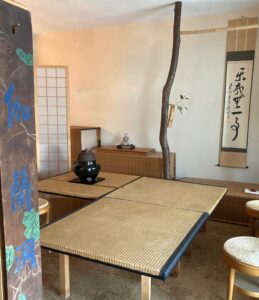
Ga-ran-dō, 伽蘭洞, Attend-orchid-cave, Tearoom set for naka-oki, 中置, middle-place, hakobi ten-mae, 運點前, carry offer-fore, Tea presentation. Toko-no-ma, 床の間, floor-’s-room, kake-mono, 掛物, hang-thing, with calligraphy, ‘Hon-rai mu ichi butsu’, 本来無一物, Origin-from not one thing. Kake hana-ire, 掛花入, hang flower-receptacle, take, 竹, bamboo, by Nishi-kawa Bai-gen, 西川楳玄, West-river Prunus-mystery, Kyōto. Ko-ma kō-gō, 独楽香合, solitary-pleasure incense-gather, red-lacquered wood, on a pack of kami kama-shiki, 紙釜敷, paper kettle-spread. Ki-men bu-ro, 鬼面風炉, demon-face wind-hearth, iron and bronze. Only the furo is displayed in the Tearoom in the center of the tatami for the hakobi naka-oki presentation. All of the other Tea utensils will be carried into the room, for a hakobi ten-mae, 運點前, carry offer-fore. At the near left is the kan-ban, 看板, see-board, for Garandō.
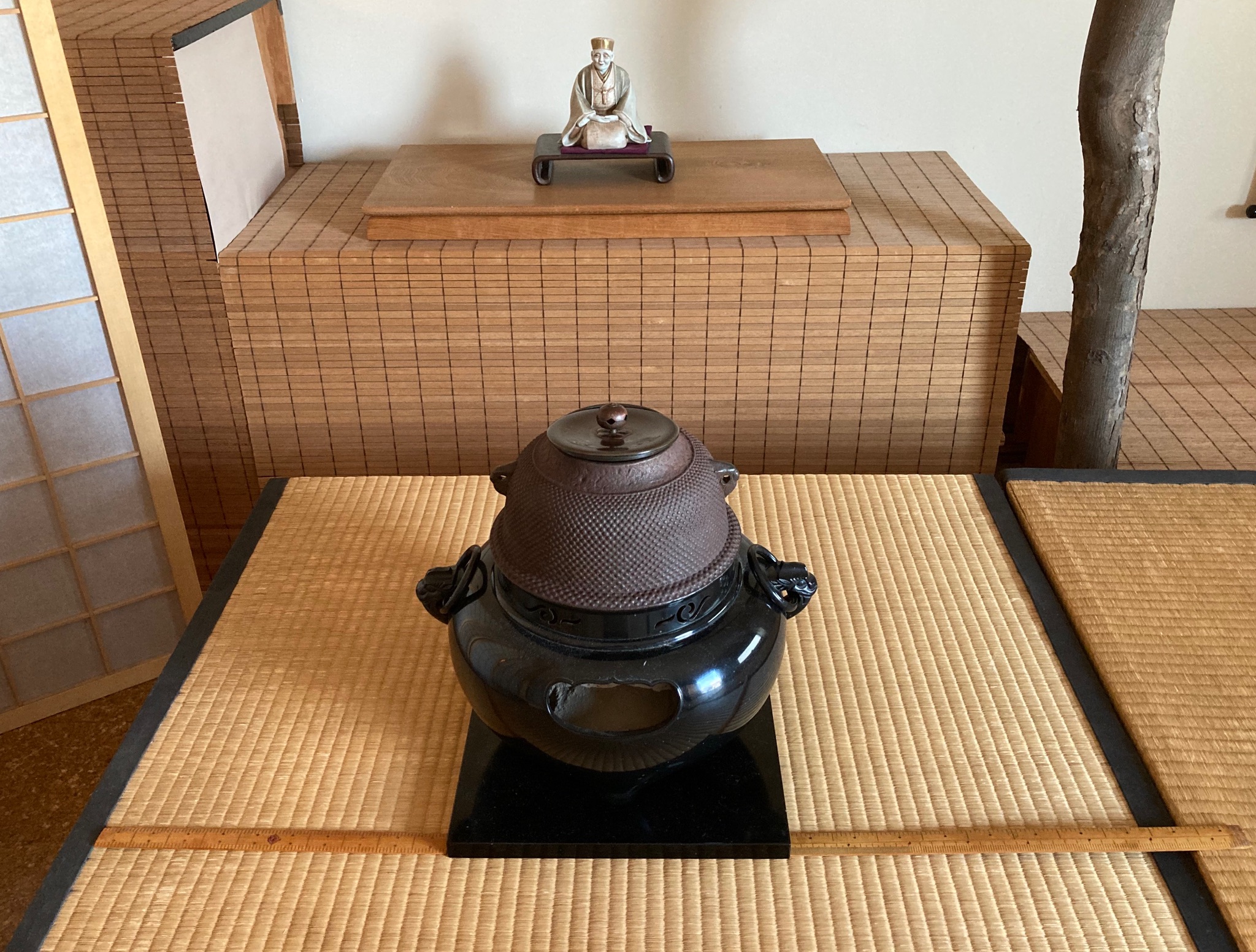
Ki-men bu-ro, 鬼面風炉, demon-face wind-hearth, iron and bronze, by Kana-mori Jō-ei, 金森浄栄, Gold-woods Pure-splendor, placed in the center, naka-oki, 中置, middle-place, of the dō-gu tatami, 道具畳, way-tool tatami. The pictured tatami are Kyō-ma, 2.5 shaku kujira-jaku. The shiki-ita, 敷板, spread-board, black-lacquered wood; W. 9.5 sun kane-jaku. To the left of the shikiita is a kane-jaku, 曲尺, bend-span, ruler, which is the exact measurement between the board and the inside of the tatami heri. This measurement is equal to 8 sun kujira-jaku. To the right of the shikiita is a kujira-jaku, 鯨尺, whale-span, ruler; the distance between the board and outside of the tatami is 8.8 sun kujira-jaku.
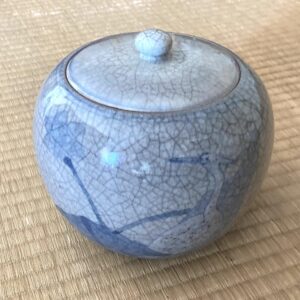
In the realm of the Japanese Tea Ceremony, Cha-no-yu, 茶の湯, Tea-’s-hot water, the simplest presentation of Tea may be the most significant.
In Chanoyu, there is a Tea presentation when most of the utensils are carried into and out of the Tearoom by the tei-shu, 亭主, house-master, in the presence of the guests, which is called a hakobi ten-mae, 運び点前, carry offer-fore. It also is called hira–den-mae, 平点前, plain-offer-fore. Such a presentation is usually when preparing usu-cha, 薄茶, thin-tea. The source of hot water is a fire contained in a portable brazier, fu-ro, 風炉, wind-hearth, or the hearth set in the floor, ro, 炉, hearth, that is already in the room.
According to Sen Ri-kyū, 千利休, Thousand Rich-quit, the ideal cha-shitsu, 茶室, tea-room is the yo-jō-han, 四畳半, four-mat-half. The following is his testament to the true purpose of Chanoyu.
Mizu wo hakobi, maki wo tori, yu wo wakashi, cha wo tatete, futsu ni kyōe, hito ni hodokoshi, ware mo nomu.
水を運び、薪をとり、湯を沸かし、茶をたてて、仏に供へ、人に施し、我も飲む.
Water carry, firewood gather, hot water boil, tea make, buddha to offer, person to alms, self as well drink.
Chanoyu of the small room, ko-ma, 小間, small-room, is above all a matter of performing practice and attaining realization in accord with the Buddhist path. For Sen no Rikyū, ‘small room’ meant the yo-jō-han, 四畳半, four-mat-half, cha-shitsu, 茶室, tea-room. Shelter is enough when the roof keeps off the rain. Food is sufficient when it is enough to stave off hunger. This is the Buddhist teaching and the fundamental meaning of Chanoyu. We draw water, gather firewood, boil the water, and make Tea. Offer tea to the Buddha, serve it to others, and drink it yourself. Arrange flowers and burn incense, in all of this, we follow the ways of the Buddha and the ancestors.
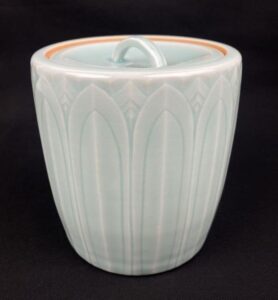
In the hakobi Tea presentation, the teishu is in the mizu-ya, 水屋, water-room, outside the door to the tearoom, cha-dō-guchi, 茶道口, tea-way-opening, with the mizu-sashi, 水指, water-indicate, to the side, opens the sliding door, and says that tea will be offered: “I-ppuku sashi agemasu”, 一服差し上げます, One-dose raise up, bows together with the guests, and carries the mizusashi into the room, and places it near the hearth. The cha-ki, 茶器, tea-container, and the cha-wan, 茶碗, tea-bowl, are carried into the room and placed near the mizusashi, this is followed by carrying in the ken-sui, 建水, build-water, futa-oki, 蓋置, lid-place, and hi-shaku, 柄杓, handle-ladle.
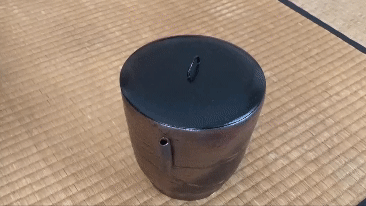
When taking the mizusashi, both hands are held against the sides of the vessel with the sides of the hands barely touching the floor. The fleshy pad of the palm of the hand, near the fingers, are at the middle of the ‘east and west’ sides of the vessel.
Rikyū’s expression, “carry water”, is enacted even when the mizusashi is displayed on a tana. The host carries water into the Tea room in a pitcher, mizu-tsugi, 水次,water-next, to replenish the mizusashi, and thus fulfilling Rikyū’s request to “carry water”.
The term ‘hakobi’, 運び, has part of its origins in the theater of Nō, 能, Skill. ‘Hakobi’ refers to a manner of walking on the stage with the foot flat on the floor sliding forward and then raising and lowering the foot off of the floor, and sliding. It is more of a dance move than actually striding. This is this manner of walking in the Tearoom.
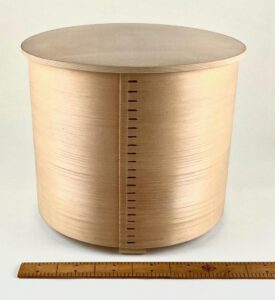
The standard mizusashi is found in Rikyū’s bentwood mage mizu–sashi, 曲水指, bend water-indicate, which has a maximum diameter 6 x 6 sun kane-jaku. This is the ideal size of the area on the tatami allotted the mizusashi. The significance of the number 6 may found in the I Ching, Eki-kyō, 易経, Change-sutra, because there are six divination lines in a hexagram.
Fine tatami are made of a type of reed called i-gusa, 藺草, rush-grass, Juncus effusus var. decipiens, which is made hollow by removing the pith, which is used to make wicks for oil lamps. It should be remembered that when the Buddha was seeking enlightenment, he sat beneath a pipal tree, seated facing east on a cushion of some grasses called kusa in Sanskrit. The Japanese word for grass is kusa, 草. The pipal tree is called bo-dai-ju, 菩提樹, grass-carry-wood, the sacred fig, Ficus religiosa; also known as the bodhi tree, bo tree, etc. We might remember this when entering the Tearoom.
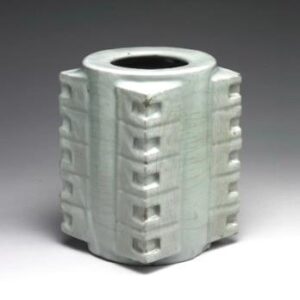
The kong, Japanese sō, 琮, square piece of jade with hole in middle; ancient Chinese jade, bronze, ceramic object of square section with designs influenced by the hexagrams of the I Ching, Ekikyō. The top and the bottom of the vessel are round, which, according to the I Ching, identifies that Earth and Heaven are round. Round is In, and cornered is Yō.
Water vessels are an important aspect in Buddhism, and one particular deity that is associated with a water vessel is Sei-shi Bo-satsu, 勢至菩薩, Strength-attain Grass-buddha. As with some Buddhist deities, the gender is not specific, and a deity may be a male in female form, and Seishi is one of them. The vessel that Seishi has, is shown on his crown, and is called a sui-byō, 水瓶, water-bottle, however, its contents is kan-ro, 甘露, sweet-dew, an elixir of life.
Traditionally, Seishi Bosatsu is depicted holding both hands together in a mudra called ga-sshō-in, 合掌印, together-hands-sign. Some other images of Seishi depict the deity holding in the left hand a bunch of six fully blown lotuses, and his right hand displays the Varada-mudra, fingers outstretched and pointing downward, the gesture of generosity, or he may be depicted holding a sword in the right hand, and a lotus in the left.
All Bosatsu practice the Roku-ha-ra-mitsu, 六波羅蜜, Six-wave-spread-honey, Six Perfections, to attain enlightenment. The Six Paramitas: Generosity, Discipline, Patience, Diligence, Concentration, Wisdom. Seishi Bosatsu is the Buddha of Wisdom. The Six Perfections may be identified with the six lotuses held by Seishi.
In Buddhism, a container of water symbolizes the Dharma. The water is clean, symbolizing that our minds need to be as pure as the water. It is calm, without a single ripple, symbolizing the tranquility in the heart, and purity and equanimity of mind.
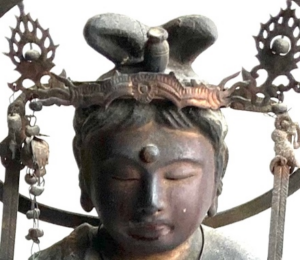
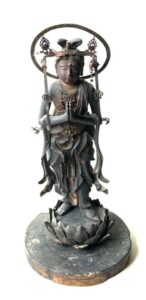
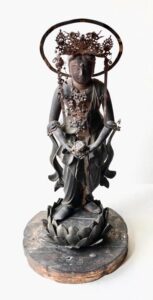
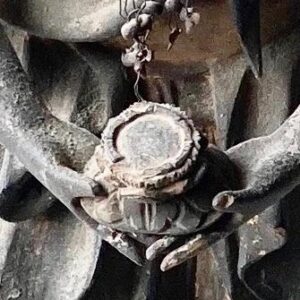
Left: sculptured head of a figure of Sei-shi Bo-satsu, 勢至菩薩, Strength-attain Grass-buddha, showing a very small representation of a sui–byō, 水瓶, water-bottle, containing kan-ro, 甘露, sweet-dew, on his head, gilded wood; Muromachi period, full height of figure is 8 sun kane-jaku; Japan.
Middle: two figures – left: walking Sei-shi Bo-satsu, 勢至菩薩, Strength-attain Grass-buddha, gilt wood, Muromachi period; H. 8 sun kane-jaku. Companion of Kan-non Bo-satsu, 観音菩薩, See-sound Grass-buddha, the Buddhist goddess of mercy. Middle – right: figure of walking Kan-non Bo-satsu, 観音菩薩, See-sound Grass-buddha, the Buddhist goddess of mercy, carrying (hakobi, 運び) a lotus seedpod surrounded by petals, gilt wood, Muromachi period; H. 8 sun kane-jaku. Part of a grouping of A-mi-da San-zon, 阿弥陀三尊, Praise-increase-steep Three-lords, that is also called a Rai-go, 来迎, Coming-welcome, when Amida, is accompanied by Seishi and Kannon, approaches to guide a departed soul to his paradise of Jō-do, 浄土, Pure-land, in the west.
Right: sculptured image of a lotus seedpod held in the hands of a figure of Kan-non Bo-satsu, 観音菩薩, See-sound Grass-buddha.
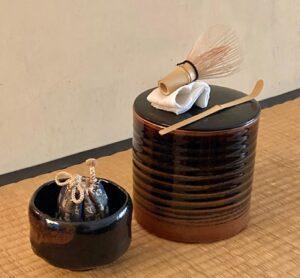
There are several Tea presentations called Kazari-mono, 荘物, solemn-thing, when a particular Tea utensil is featured, for example Cha-wan Kazari, 茶碗荘, Tea-bowl Dignify. These presentations have a display of the mizu-sashi, 水指, water-indicate, with a cha-kin, 茶巾, cha-sen, 茶筅, and cha-shaku, 茶杓, tea-scoop, arranged on its nuri-buta, 塗蓋, lacquered-lid. The cha-ire, 茶入, tea-receptacle, is placed inside of the cha-wan, 茶碗, tea-bowl, and then placed in front of the mizusashi. These utensils are displayed in the Tearoom before the arrival of the guests. For these presentations, only ken-sui, 建水, build-water, hi-shaku, 柄杓, handle-ladle, and futa-oki, 蓋置, lid-place, are carried into the room in the presence of the guests.
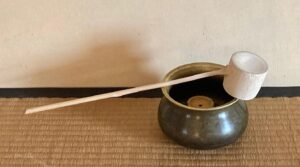
The ken-sui, 建水, build-water, is in the form of ‘e-fugo’, 餌畚, food-hamper, Kara-kane, 唐銅, Tang-copper, bronze. The kensui is also called koboshi, 零し, spiller, which is wordplay on ko-bō-shi, 小法師, little-law-master, minor Buddhist official. The Kanji for koboshi, 零, also means zero. There may be wordplay on fugo; fu-go-sen, 不語仙, no-language-hermit, which is a word for the lotus flower.
The hakobi aspect of the Tea presentation is not only enacted at the beginning. At the conclusion of the Tea presentation when all of the utensils are carried out of the Tearoom, this too is regarded as a hakobi presentation. In the Urasenke tradition of Chanoyu, according to Gen-gen-sai, 玄々斎, Mystery-mystery-abstain, there are one hundred different ten-mae, 點前, offer-fore, ways to prepare Tea. The term hakobi ten-mae, 運點前, carry offer-fore, can be applied to several different presentations.
When all of the Tea utensils are carried into the Tearoom, or out, at the conclusion of the presentation, this could be classified as a hakobi tenmae. The sole exception of moving everything out of the Tearoom, is that the source of the fire, the furo and the ro, should not be taken from the Tearoom. Because of the potential destructive nature of fire, it must have a fixed place. In traditional life, a fire is kept burning much of the time, so that the fire god will go to the hearth, and not start a new fire elsewhere. Tile roofs are created to resemble the waves of a lake or other body of water in an attempt to mislead the fire god.
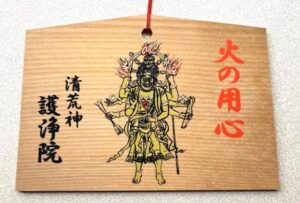
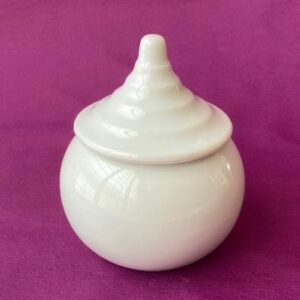
This vessel was the inspiration for the Sen families tsubo-tsubo mon, ツボツボ紋, jar-jar-crest, with the lid removed, which became the ko-ma mon, 独楽紋, solitary-pleasure crest, a top, of the Iemoto. Followers of a Sen family who wear the tsubo-tsubo crest offer water to Iemoto.
A mizu–tama, 水玉, water-jewel, offered to Kō-jin-sama, 荒神様, Rough-god-lord, the Shintō Buddhist guardian of the kitchen and especially, the kamado, 竈, stove. This offering is enacted in the Tearoom when placing the mizusashi near the hearth. The water is protection against fire, as well as an offering to appease the fire deity. In addition to carrying the mizusashi, other utensils are also carried into the Tearoom, such as the chawan, chaki, chashaku, chakin, chasen, as well as the kensui, futaoki, and hishaku.
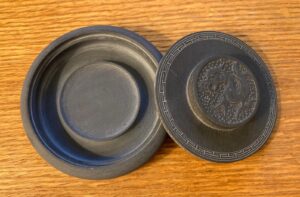
When searching for an association between the word kensui for the waste-water bowl and other possibilities, I discovered there is a spring a connected to Fu-dō Myō-ō, 不動明王, No-move Bright-king. There is in the general vicinity of Mt. Fuji an on-sen, 温泉, hot-spring called Fu-dō-yu, 不動湯, No-move-hot water, that has been famous for centuries. Nearby is a shrine dedicated to Fudō, where there is a spring of fresh pure water named Ken-sui Fudō-son no rei-sui, 硯見 不動尊の霊水, Inkstone-see No-move-lord ’s sacred-water. The place name is also read suzurimi. The source of its name is that Minamoto Yori-tomo, 源頼朝, Origin Trust-regime, 12th century aristocrat, drew water from the spring to wet his inkstone to write a letter. Because of the shrine’s spring’s limited output, drawing water is quite restricted.

The word ken-sui, 硯水, inkstone-water, is also given to water used on a suzuri, 硯, inkstone, or to the vessel in which it is held, such as a sui-teki, 水滴, water-dripper. One of the shi-teki, 四滴, four-drippers, four jars used to hold powdered usu-cha, 薄茶, thin-tea. It should be remembered that the handle of a pitcher is usually the shō-men, 正面, of the utensils; the water is poured toward deity in the north.

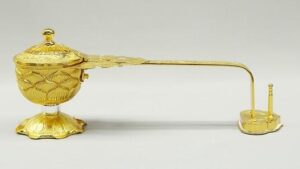
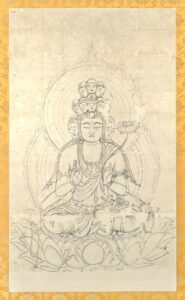
Image of Jū-ichi-men, 十一面観音菩薩, Ten-one-head See-sound Grass-buddha, seated on lotus, with a crown of ten heads. She is depicting holding a lotus in her upper left hand, with her upper right hand in the Prithvi Mudra of ‘Earth’ (ring finger) touching ‘Fire’ (thumb); the lower left hand holds the sui-byō, and there are prayer beads in the right hand. Princeton University Art Museum, New Jersey.
The group of necessary things carried into the Tearoom consists of mizu-sashi, 水指, water-indicate, lid, mizu, 水, water, cha-kin, 茶巾, tea-cloth, cha-sen, 茶筅, tea-whisk, cha-shaku, 茶杓, tea-scoop, cha-wan, 茶碗, tea-bowl, cha-ki, 茶器, tea-container, cha, 茶, tea, lid, shi-fuku, 仕覆, serve-cover. This is a total of eleven things. One of the most important Buddhist deities is Jū-ichi-men Kannon, 十一面観音菩薩, Ten-one-faces Kannon. Typical of images of Kannon, is that she holds a lotus flower, often in a sui-byō水瓶, water-bottle, with her left hand. Sen-jū-kan-non Bo-satsu, 千手観音菩薩, Thousand-hand-see-sound Grass-buddha, holds the wish-granting nyo-i hō-ju, 如意宝珠, as-wish treasure-jewel, in her right hand.
Seishi has on his crown a small image of a sui-byō, 水瓶, water-bottle, which contains kan-ro, 甘露, sweet-dew, amrit, an elixir of life. The suibyō, or mizu-game, is symbolic of the wisdom of the Buddha. Although Seishi is not depicted holding the suibyō, his hands are in the mudra of Anjali Mudra, or gasshō in Japanese. Mudras are essential to the understanding of the manner in which Buddhist deities hold their hands. The Sanskrit word, ‘mudra’, means ‘seal’. When handling Tea utensils, the hands should be in correct locations, and with specific intent, and some of these ways of handling must surely relate to Buddhism and other beliefs.
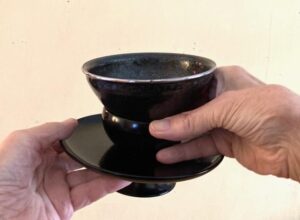
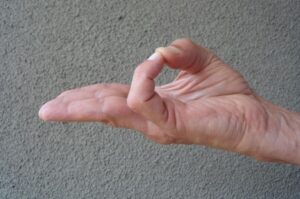
When carrying a Dai-ten-moku the little finger of the right hand is crooked and placed under the hō-zuki, 鬼灯, demon-lamp, cup that holds the Tenmoku teabowl. This curious aspect may be identified with a hand gesture called a mudra, in-zō, 印相, sign-phase, and if so, it may be related to the Varuna mudra: tip of little finger touches the tip of thumb, with the other three fingers fully extended and kept parallel; the middle finger and index finger are held together. Aspects of the Varuna mudra are associated with taste sense; it balances water content and prevents diseases caused by lack of water. The mudra is believed to retain clarity in the blood by balancing water in body, and prevents pain of gastroenteritis and muscle shrinkage. The mudra is also believed to relieve dehydration. These references to water seem apropos to the dai which supports the teabowl, which is purified with hot water.
In the Amida Rai-gō, 阿弥陀来迎, come-welcome, Amida is preceded by Kannon, and then Seishi. However, in the Jō-do, 浄土, Pure-land, Amida has Seishi at his right hand and Kannon near his left hand. Seishi has his hands upright in prayer, and is Yō and they point toward Amida’s ‘paradise’. Kannon has her hands flat with the palms facing up holding a lotus flower/water, and is In. In the story of their lives, Kannon is the older brother of Seishi. Kannon and Seishi are the In, 陰, negative, and Yō, 陽, positive, aspects of Amida.
Sen-ju Kan-non Bo-satsu, 千手観音菩薩, Thousand-hand See-sound Grass-buddha, as her name indicates, has a thousand hands, and each hand holds some utensil or implement, which means that she can do anything. When depicted in simple human-like form, Kannon’s two principal hands support a lotus flower and pod, on which one is reborn in Amida’s paradise.
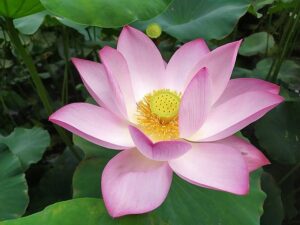
The lotus, and its parts, may be identified with certain Tea utensils. The original Ten-moku, 天目, Heaven-eye, teabowl has the form of the lotus seedpod, ren-niku, 蓮肉, lotus-flesh. The many stamen, o-shibe, 雄蕊, male-stalk, that encircle the seedpod might be identified with the multiple tines of the bamboo chasen. One might imagine that the green seeds of the lotus pod could represent the green matcha itself. The bent stem of a lotus flower might be identified with the bamboo chashaku that is carried into the Tearoom on the chawan. The stem of the lotus, like the stalk of bamboo, is hollow. Buddhists wish to be empty, like the lotus and bamboo.
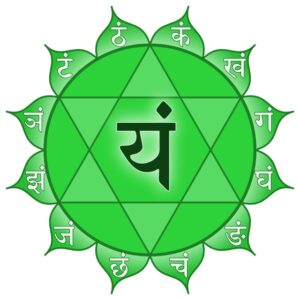
Anahata chakra, Heart chakra. Located near the human heart. This is the location where the chawan is held when carrying it into the Tearoom. Its central symbol bija, seed sound, is Yam. Chanting Yam brings about peace, contentment, joy, love and compassion. Its color is green, the circle and the six triangles represent Water. It has twelve lotus petals, each with a Sanskrit bija, seed sound. The Anahata chakra is the fourth of seven basic chakra of the human body.
Perhaps the twelve petals may be identified with twelve months of the year, or the jū-ni-shi, 十二支, ten-two signs, the Asian zodiac. In Jō-do, 浄土, Pure Land, Buddhism there are the Jū-ni-rai, 十二礼, Ten-two-adorations, of A-mi-da, 阿弥陀, Praise-increase-steep, and Amida is deeply associated with the lotus. The two intersecting triangles could evoke the dual aspects of the chasen.
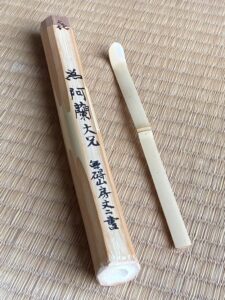
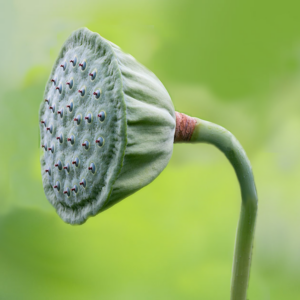
Left: cha-shaku, 茶杓, tea-scoop, made of bamboo and bent to form a scoop, by Kuro-da Jō-ji, 黒田丈二, Black-ricefield Height-two; tsutsu, 筒, cylinder, bamboo, made by his father, Kuro-da Tatsu-aki, 黒田辰秋, Black-ricefield Dragon-autumn, Nin-gen Koku-hō, 人間国宝, Person-interval Country-treasure, Living National Treasure. Branded at lid join, yorokobi, 㐂, joy, representing ki-ju, 喜寿, joy-longevity, the age of 77. The tube is signed A-ran Tai-kei, 阿蘭大兄, Praise-orchid Big-(older) brother, and Mu-ge-san-bō, 無碍山房, No-obstacle-mountain-(monk’s) hut. Hi-no, 日野, Sun-field, Uji. Right: bent stem of a lotus; the lotus seedpod turns upside down, and the seeds fall into the water to begin new life.
Fifty-some years ago, friend, Kuro-da Jō-ji, 黒田丈二, Black-ricefield Height-two, gave me one of his chashaku and one of his father’s bamboo tsutsu, 筒, cylinder. He wrote my name, Allan, in his choice of Kanji that are read a-ran, 阿蘭, Praise-orchid. For ‘a’ he chose 阿 which begins the name of A-mi-da, 阿弥陀. The gentle pointed end, tsuyu, 露, dew, reminded me of the tip of a lotus petal. In his neighborhood of Hi-no, 日野, Sun-field, is the site of Hō-kai-ji, 法界寺, Law-world-temple, a Jō-do, 浄土, Pure-land, temple with a votive statue of Amida, believed to surpass the beauty of the Amida statue at nearby Byō-dō-in, 平等院, Peace-order-sub temple, in Uji. That afternoon, we walked a short distance to the temple to see the Amida. The grounds were quiet. We were the only ones there. Inside the worship hall, the golden image of the Buddha of Mercy glowed in the dark solitude. It was a moment not unlike Amida’s Goku-raku, 極楽, Extreme-pleasure.
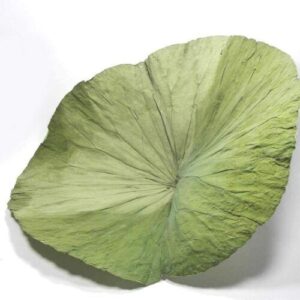
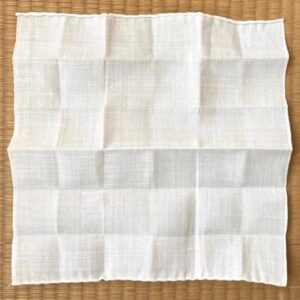
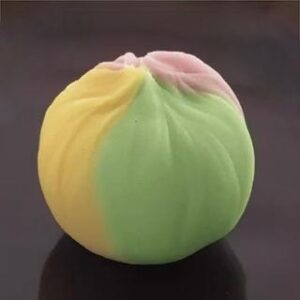
Left: lotus leaf. Middle: shin cha-kin, 茶巾, 8 x 8 sun kujira-jaku. Right: o-ka-shi, お菓子, hon.-sweet-of, sweetened bean jam formed in a cha-kin, 茶巾, tea-cloth
Because of their very nature, the leaves of the lotus plant have been used like paper, or fabric, to wrap foods and other things. Their textured surface repels water and even some dirt, and semi-dried leaves have been used for centuries to steam foods especially rice mixtures. Large lotus leaves are used as rain hats.
The shin chakin is 8 x 8 sun kujira-jaku. The size and shape of the chakin gave some hints as to other connections, such as the Ryō-kai Man-da-ra, 両界曼荼羅, Both-world Wide-weed-spread; Tai-zō-kai, 胎蔵界, Womb-treasure-world, and the Kon-gō-kai, 金剛界, Gold-strength-word, which are based on an eight-petal lotus. The number hachi-jū-hachi, 八十八, eight-ten-eight, is most auspicious, and is emblematic of the center of the world.


There are several ways that the chakin is used in Chanoyu other than wiping the chawan: shibori ja-kin, 絞り茶巾, wring tea-cloth, and cha–kin shibori, 茶巾絞り, tea-cloth wring. These terms seem to be used interchangeably. One Tea presentation is when a wet chakin is wrung almost dry, and put into a dry tsutsu ja-wan, 筒茶碗, cylindrical tea-bowl. There is a variation of this procedure in the Tea presentation of ‘Arai-ja-kin’, 洗い茶巾, Rough-tea-cloth, when a chakin is taken wet from the bowl of water in the mizu-ya, 水屋, water-room, folded into a triangle, and placed in a hira-ja-wan, 平茶碗, wide-tea-bowl, half-filled with water, and later in the presence of the guests, is taken out and wrung almost dry, and folded.
Another use of the chakin is in the creation of a sweet that is made with a damp chakin which is temporarily wrapped around a portion of an, 餡, sweetened bean paste, or sweetened pureed sweet potato, chestnut, etc, to give it the form of a hō-ju, 宝珠, treasure-jewel.
The lotus plant grows in water, and thus is associated with water, although the leaves dispel water or form beads of water on its surface. The lotus leaf could be identified with the hemp fiber fabric of the cha-kin, 茶巾, tea-cloth. Both are folded up. In truth, the leaf and the chakin are quite opposite or contrasting in several ways: the leaf is round and repels water, the chakin is four sided and absorbs water, as it should, because it is wet when used to wipe a chawan. When the leaf is used, it surrounds, encloses the contents, whereas the chakin is placed in the chawan and is used to wipe the outside and inside the bowl.
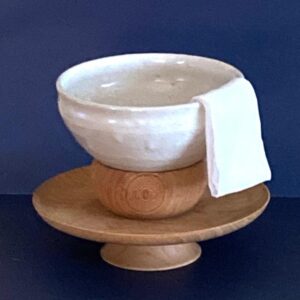
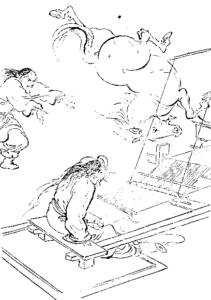
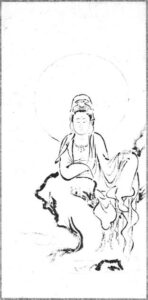
Left: white ceramic ‘Ten-moku’ cha-wan, 天目茶碗, Heaven-eye tea-bowl, conical bowl with clear to white glaze, by Kasa-hara-yaki, 笠原焼, Umbrella-field-fired, Shi-no, 志野, Aspire-field, made for Yaku-shi-ji, 薬師寺, Medicine-master-temple, Nara; with a damp chakin laid over the rim of the bowl, and supported on a plain keyaki, 欅, zelkova, wood ki-nin dai, 貴人台, noble-person support. Center: picture of Su-sa-no-o, 素戔男, Elementary-sword-male, Elementary-remain-male, throwing a piebald colt into the loom of the cowering Ama-terasu, 天照, Heaven-brighten, who wove hempen garments for the gods. Right: picture of Byaku-e Kan-non, 白衣観音, White-robe See-sound, seated on a rocky crag, with the full moon; unknown Japanese artist.
Perhaps, some Tea followers might associate the white hemp chakin with the hemp fabric woven by Ama-terasu, 天照, Heaven-brighten, the Shintō sun goddess, or Buddhists may associate the chakin with the white robe of Byaku-e Kan-non, 白衣観音, White-robe See-sound. Buddhist robes, in the Pali tradition, are made of six kinds of cloth are allowed for making the upper and outer robes of the ‘triple robe’: plant fibers, cotton, silk, animal fur, hemp, and a mixture of some, or all, of them. The Byaku-e Kan-non, 白衣観音, White-robe See-sound, is one of the thirty-three manifestations of Kannon Bosatsu. The white robe is worn by laypeople, rather than the colorful robes worn by priests.
Kannon is depicted wearing a long-flowing white robe that often covers over the top of her crown. Frequently, she is shown with an image of the full moon, or on a dragon, a lotus petal, a cliff, etc. Towering monumental figures of Kannon have been constructed in various locations throughout Asia. In Kyōto, a monumental, seated figure of Ryō-zen Kan-non, 霊山観音, Spirit-mountain See-sound, is shown wearing a white robe. The White-robed Kannon is depicted in the Lotus section of the Tai-zō-kai Man-da-ra, 胎蔵界曼荼羅, Womb-keep-world Wide-weed-spread.
There are countless mandalas in Japan, depicting ideal realms which are often connected with Buddhist iconography. One of the earliest and most revered is a treasure of Tai-ma–dera, 當麻寺, Accept-hemp-temple, in Nara, which was founded in the 7th century. The Tai-ma Man-da-ra, 當麻曼荼羅, Accept-hemp Wide-weed-spread, created in the 8th century, is made of woven lotus stem fibers. The intricate images depict the Pure Land paradise of Amida, who is located in the middle of the scene surrounded by deities in an architectural setting. Images of Seishi and Kannon are at his sides. The temple is famous for its many historical structures and treasures, including lotus ponds that have lotus flowers that bloom in June. Many Buddhist temples have one or two hasu no ike, 蓮の池, lotus’s pond, often located near the front entrance to the temple grounds. Perhaps the most revered sutra is the Ho-ke-kyō, 法華経, Law-flower-sutra, the Lotus Sutra.
There is a Buddhist expression about the lotus:
蓮の恩恵を受けて開運に繋げていきましょう。
Hasu no on-kei wo ukete kai-un (hakobi) ni tsunagete ikimashō.
Lotus of kind-grace of receive open-carry to connect together.
The Kanji, 蓮, is read ren and hasu, and is composed of the Kanji, kusa kanmuri, 艹, grass crown, and ren, 連, take along. The Kanji, 連, is composed of chaku, 辵, walk, and sha, 車, carriage. The ring of petals of the fully open lotus flower resembles a wheel with many spokes. The Japanese word for walk is aruku, 歩く, to walk, step, pace, stroll, etc. The word to run is hashiru, 走る, to run.
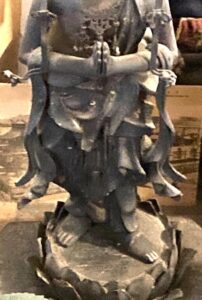
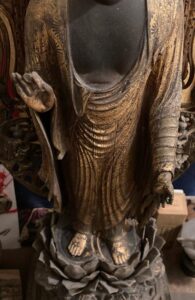
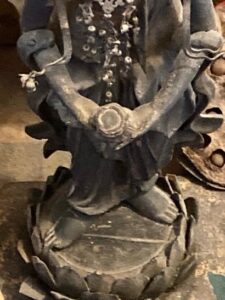
Details of A-mi-da San-zon, 阿弥陀三尊, Praise-increase-steep Three-lords; gilt-wood figures. Left: Seishi Bosatsu. Center: Amida Nyorai. Right: Kannon Bosatsu. The approach of Amida Nyorai preceded by Seishi and Kannon is called Rai-gō, 来迎, come-greet, which is to accompany departed spirits to Amida’s paradise of Goku-raku Jō-do, 極楽浄土, Extreme-pleasure Pure-land.
The figure of A-mi-da Nyo-rai, 阿弥陀如来, Praise-increase-steep Like-become, is in the act of approaching, Raigō, 来迎, Come-greet, with his left foot forward of his right foot. Customarily in Japan, when entering a sacred area, one should enter with the left foot, and leave the place with the right foot. In the Urasenke tradition of Chanoyu, one enters the Tearoom with the right foot and exits with the left. One should step into and onto the raised floor of the tokonoma with the left foot. With the left foot in the sacred space, the right foot remains outside of the space. In Rikyū’s ideal yo-jō-han cha-shitsu, 四畳半茶室, four-mat-half tea-room, when entering the tokonoma with the left foot, one faces east toward the rising sun, with the back to the west, and the western paradise of Amida.
When entering the Tearoom where there is a mawari cha-dō-guchi, 廻茶道口, turn-tea-way-opening, one enters with the right foot, while the left foot remains in the mizuya, one faces north, the place of Kannon Bosatsu, and toward the northwest, which is the realm of Amida.
Amida is often depicted not carrying any implement, but holds his hands in various mudra. Depicted in the picture above; his left hand is directed downward to welcome spirit, and his right hand is directed upward, pointing the way to his paradise of Jōdo.
In the Raigō, Seishi approaches with the left foot forward, like that of Amida. On the contrary, Kannon approaches with the right foot forward, opposite that of Amida. Seishi’s hands are held together upright in the gasshōin, similar to Amida’s right hand. Kannon’s hands are lowered, holding the lotus, similar to the lowered left hand of Amida. For each step that Amida takes, a new lotus manifests to support his approach.
Kannon holds the lotus so that the departed soul may be reborn on it in Amida’s paradise, just as Amida’s left hand beckons the soul with his left hand. Seishi directs the soul upward like the right hand of Amida, showing the soul toward his Paradise. The right hand of Amida is shown in a positive aspect, Yō, 陽, penetrative, and his left hand, In, 陰, negative, receptive.
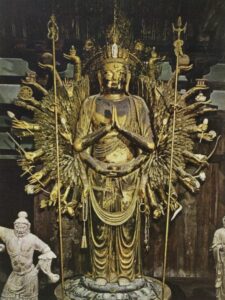
Gilt-wood figure of Sen-jū-kan-non Bo-satsu, 千手観音菩薩, Thousand-hand-see-sound Grass-buddha, in Tō-shō-dai-ji, 唐招提寺, Tang-beckon-carry- temple, Nara. Two of the four principal hands of Kannon are held together upright like the ‘prayer’ hands of Seishi Bosatsu, whereas the other two of the four hands are lowered to where Kannon would hold the lotus flower. Other depictions show that the lower two hands are holding a hō-ju, 宝珠, treasure-jewel, which is manifest as a ya-kki, 薬器, medicine-container, a taku-hatsu, 托鉢, an alms-bowl. The images of Senjū-Kannon with a thousand hands, also have jū-ichi-men, 十一面, ten-one-faces. There are san-jū-san, 三十三, three-ten-three, different manifestations of Kannon. Images of Buddhist deities, such as Kannon, covered in gold leaf indicate that the deity is a source of Light. All of these attributes symbolize Kannon’s infinite abilities to see and do any, and everything, everywhere. In the ideal yojōhan chashitsu, Senjū-Kannon is metaphorically located in the north and may be identified with the toko-bashira, 床柱, floor-post, of the alcove.
Koicha Hakobi:
The plain Tea presentation of koi-cha, 濃茶, thick-tea, begins with the mizusashi placed near the hearth, and the chaire is placed in front of the mizusashi before the guest enters the Tearoom. The presentation starts with the teishu in the mizu-ya, 水屋, water-house, seated at the chadō-guchi, with the omo-ja-wan on the floor between the door and the host’s knees. The door is opened, and without bowing, the teishu carries the chawan into the Tearoom, and places it near the wall in a location called kari-oki, 仮置き, temporary-place. The teishu moves the chaire a little toward the guest, and places the chawan to the left of the chaire. The teishu returns to the mizuya, and brings the kensui with the futaoki and hishaku into the Tearoom, faces the door, and closes it. The teishu carries the kensui, futaoki and hishaku, and places each of them in their appointed locations. With the placement and drop of the hishaku handle, all of the participants bow in unison which begins the preparation of the tea.
The relationship between the chaire and chawan placed in front of the mizusashi is different from the locations of Seishi and Kannon. In the Rai-gō, 来迎, come-welcome, their relationship is with Kannon on the right and Seishi on the left. With the chaire representing Seishi’s water bottle, and the chawan representing Kannon’s lotus, it may be that with the them in front of the mizusashi they are facing the mizusashi, as though they are ‘returning’ to the Jō-do, 浄土, Pure-land, of Amida.
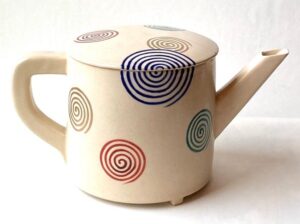
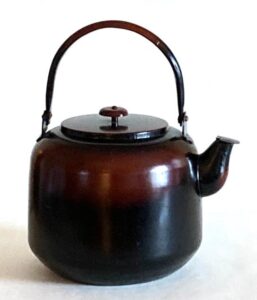
An essential vessel that is used to carry water in many Tea presentations is the mizu-tsugi, 水次, water-next. There are various forms of the mizutsugi, and the most familiar are the kata-kuchi, 片口, side-mouth, and the ya-kan, 薬缶, medicine-boiler. A folded, damp chakin is placed on the lid of either mizutsugi to catch drips and dab-up spills.
The mizutsugi is carried with both hands, and in the hon-ga-tte cha-shitsu, 本勝手茶室, true-prevail-hand tea-room, the mouth of the mizutsugi is usually directed toward the right, and the vessel is parallel to one’s body. The spout is opposite the shō-men, 正面, true-face. The left hand forms a circle around the handle, and the right hand is held flat against the side below the spout: In and Yō. When pouring water into the mizusashi, or kama, 釜, kettle, the chakin is held at the base of the spout.
When carrying the katakuchi, the C-handle is held with the left hand, and the spout is held with the right hand near the base of the spout. When the yakan is carried, the basket-handle is held with the left hand on top, and the spout is held with the right hand near the base of the spout.
When drinking a standard amount of usu-cha, 薄茶, thin-tea, a person takes three mouthfuls into the mouth and drinks each mouthful in three sips, which makes nine swallows. To finish the tea, one takes a final somewhat louder sip to alert the host the tea has been drunk. With the final sip, it may be that the intention is to make 9.5 sips. The number 9.5 is found in the measurements of a number of Tea utensils: the length of the kazari hi-bashi, 飾り火箸, display fire-rods, is 9.5 sun kane-jaku, and several other objects.
When koi-cha, 濃茶, thick-tea, is served at a gathering of an ideal number of four guests, the tea for the four guests is prepared in a single chawan, which the guests in turn drink three mouthfuls of tea. The total number of sips is thirty-six. The last guest is the only one of the guests to make the noticeable final sip, which adds one sip – thirty-seven.
The number of petals on a fully realized imperial chrysanthemum crest is thirty-six, plus the center, thirty-seven. In Buddhist ideology, there are hundreds of billions of petals in each sacred lotus flower. There are countless colors in the light of the flower: the color blue has blue light, white has white light, etc. Thirty-six hundred billion lights are emitted from each flower, and thirty-six hundred billion Buddhas emerge from each light. Like sand on a shore, atoms in the air.

